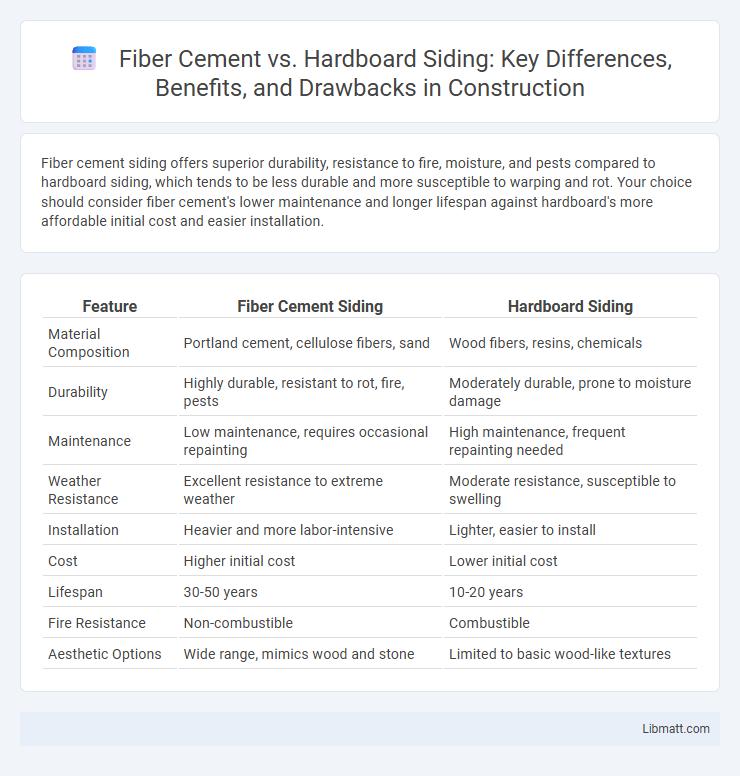Fiber cement siding offers superior durability, resistance to fire, moisture, and pests compared to hardboard siding, which tends to be less durable and more susceptible to warping and rot. Your choice should consider fiber cement's lower maintenance and longer lifespan against hardboard's more affordable initial cost and easier installation.
Table of Comparison
| Feature | Fiber Cement Siding | Hardboard Siding |
|---|---|---|
| Material Composition | Portland cement, cellulose fibers, sand | Wood fibers, resins, chemicals |
| Durability | Highly durable, resistant to rot, fire, pests | Moderately durable, prone to moisture damage |
| Maintenance | Low maintenance, requires occasional repainting | High maintenance, frequent repainting needed |
| Weather Resistance | Excellent resistance to extreme weather | Moderate resistance, susceptible to swelling |
| Installation | Heavier and more labor-intensive | Lighter, easier to install |
| Cost | Higher initial cost | Lower initial cost |
| Lifespan | 30-50 years | 10-20 years |
| Fire Resistance | Non-combustible | Combustible |
| Aesthetic Options | Wide range, mimics wood and stone | Limited to basic wood-like textures |
Introduction to Fiber Cement and Hardboard Siding
Fiber cement siding is a durable building material made from a mixture of cement, sand, and cellulose fibers, offering excellent resistance to fire, rot, and insects, making it ideal for long-lasting exterior cladding. Hardboard siding consists of a highly compressed wood fiber panel, providing a cost-effective and lightweight option with good paint adhesion and a smooth finish, though it requires regular maintenance to prevent moisture damage. Both materials serve as popular choices for home exteriors, with fiber cement known for its strength and longevity, while hardboard offers an economical and versatile solution.
Composition and Material Differences
Fiber cement siding is composed of a mixture of cement, sand, and cellulose fibers, offering a durable and fire-resistant material ideal for weather exposure. Hardboard siding consists of engineered wood fibers compressed with resin adhesives, providing a cost-effective option with moderate durability but greater susceptibility to moisture damage. The primary material difference lies in fiber cement's inorganic blend versus hardboard's organic wood fiber composition, impacting longevity and maintenance requirements.
Durability and Longevity
Fiber cement siding boasts exceptional durability, resisting rot, insects, and fire, and can last over 50 years with minimal maintenance, making it a long-term investment for homeowners. Hardboard siding, while more affordable, is prone to water damage, swelling, and insect infestation, which typically limits its lifespan to around 20 years without extensive upkeep. Choosing fiber cement siding ensures superior longevity and performance in harsh weather conditions, outperforming hardboard in terms of overall resilience.
Weather and Moisture Resistance
Fiber cement siding offers superior weather and moisture resistance due to its non-organic composition, which prevents rot, warping, and insect damage, making it ideal for humid and wet climates. Hardboard siding, made from compressed wood fibers, is more susceptible to moisture absorption, leading to swelling, cracking, and deterioration over time without proper maintenance. Choosing fiber cement ensures enhanced durability and lower maintenance costs in areas prone to heavy rain, humidity, and extreme weather conditions.
Maintenance Requirements
Fiber cement siding demands low maintenance due to its resistance to rot, insects, and fire, requiring only occasional cleaning and repainting every 10-15 years to preserve its appearance. Hardboard siding is more susceptible to moisture damage and warping, necessitating frequent inspections, regular painting, and sealing to prevent deterioration. Your choice should consider the time and effort needed for upkeep to ensure long-term durability and curb appeal.
Installation Process and Ease
Fiber cement siding requires specialized tools and protective equipment due to its weight and dust, making the installation process more labor-intensive but highly durable. Hardboard siding is lighter, easier to cut, and quicker to install, often reducing labor costs and time for Your home projects. Both materials benefit from professional installation, but hardboard siding generally offers greater ease for DIY enthusiasts.
Aesthetic Options and Versatility
Fiber cement siding offers a wide range of aesthetic options, including various textures, colors, and styles that mimic wood, stone, or stucco, providing homeowners with versatile design choices. Hardboard siding typically features a smoother, more uniform appearance but is limited in texture and color variety compared to fiber cement. The durability and customization possibilities of fiber cement siding make it a more adaptable choice for diverse architectural styles and exterior designs.
Environmental Impact and Sustainability
Fiber cement siding offers greater environmental sustainability, as it is composed of cement, sand, and cellulose fibers, all of which are abundant and non-toxic materials that resist rot and pests, reducing the need for frequent replacements. Hardboard siding, made from wood fibers and adhesives, has a smaller carbon footprint initially but tends to require more maintenance, painting, and replacement over time, potentially increasing its long-term environmental impact. Choosing fiber cement siding for your home enhances durability and reduces waste, supporting a more sustainable building choice.
Cost Comparison
Fiber cement siding typically costs between $5 to $10 per square foot installed, reflecting its durability and resistance to fire and pests. Hardboard siding offers a lower initial price, ranging from $3 to $6 per square foot, but tends to require more maintenance due to its susceptibility to moisture damage and rot. Over time, fiber cement can prove more cost-effective despite higher upfront expenses because of its long lifespan and reduced maintenance needs.
Which Siding Is Best for Your Home?
Fiber cement siding offers superior durability, resistance to fire, insects, and rot, making it an excellent choice for long-term protection and low maintenance. Hardboard siding, while more affordable and easier to install, tends to be more vulnerable to moisture damage and requires regular upkeep to prevent warping and deterioration. Homeowners seeking a balance of longevity, aesthetic versatility, and weather resistance often prefer fiber cement siding for optimal home exterior performance.
Fiber cement vs hardboard siding Infographic

 libmatt.com
libmatt.com